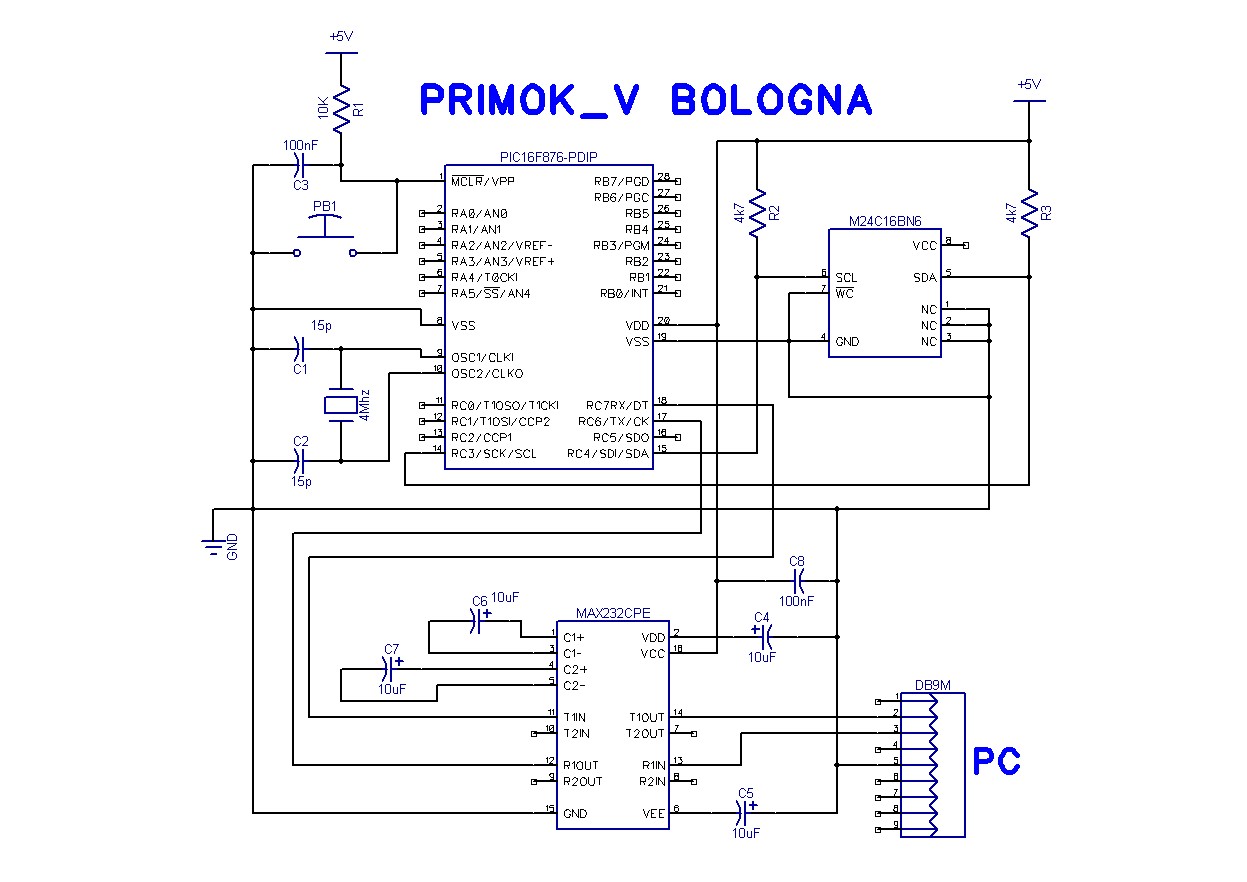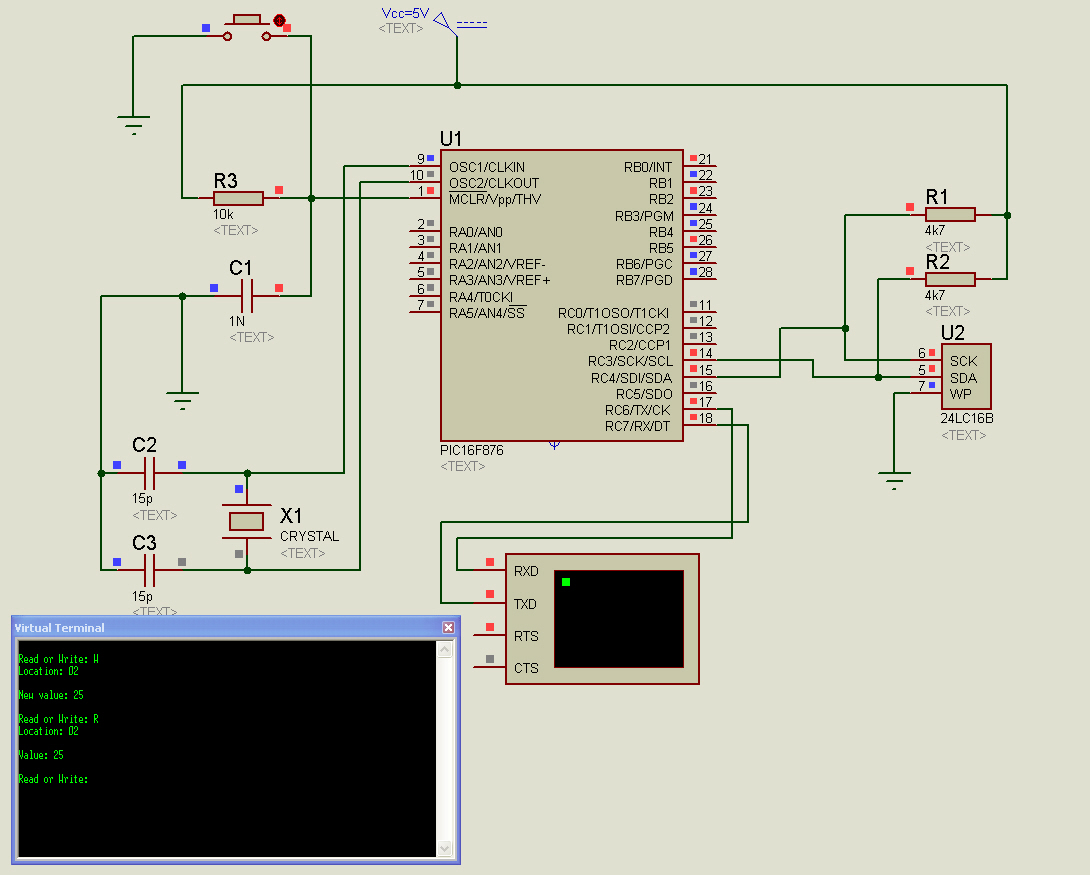Interfaccia EEPROM 24CL16 e pic 16F876
Il codice permette di interfacciare una eeprom tipo 24LC16 ad un pic 16F876.
Il protocolllo di comunicazione utilizzato è l'I2C; il quarzo usato è di 4MHz .
Le istruzioni per scrivere o leggere dalla eeprom, sono inviate tramite porta seriale
collegata al PC utilizzando un software d'interfacciamento come hyperterminal.
I parametri di settaggio sono quelli visibili nel file.h giù in basso.
SCHEMA ELETTRICO

CCS compiler
Il codice sorgente:
#include "C:\CODICI PIC\I2c_EEPROM_11_03_2011\primok_eprom.h"
#include "input.c"
void main() {
BYTE value, cmd;
EEPROM_ADDRESS address;
init_ext_eeprom();
do {
do {
printf("\r\nRead or Write: ");
cmd=getc();
cmd=toupper(cmd);
putc(cmd);
} while ( (cmd!='R') && (cmd!='W') );
printf("\n\rLocation: ");
#if sizeof(EEPROM_ADDRESS)==1
address = gethex();
#else
#if EEPROM_SIZE>0xfff
address = gethex();
#else
address = gethex1();
#endif
address = (address<<8)+gethex();
#endif
if(cmd=='R'){
printf("\r\nValue: %X\r\n",READ_EXT_EEPROM( address ) );
}
if(cmd=='W') {
printf("\r\nNew value: ");
value = gethex();
printf("\n\r");
WRITE_EXT_EEPROM( address, value );
output_B(value);
}
} while (TRUE);
}
Il file.h
#include <16F876.h>
#device adc=8
#FUSES NOWDT //No Watch Dog Timer
#FUSES XT //High speed Osc (> 4mhz for PCM/PCH) (>10mhz for PCD)
#FUSES PUT //Power Up Timer
#FUSES NOPROTECT //Code not protected from reading
#FUSES NODEBUG //No Debug mode for ICD
#FUSES BROWNOUT //Reset when brownout detected
#FUSES NOLVP //No low voltage prgming, B3(PIC16) or B5(PIC18) used for I/O
#FUSES NOCPD //No EE protection
#use delay(clock=4000000)
#use rs232(baud=9600,parity=N,xmit=PIN_C6,rcv=PIN_C7,bits=8)
#define EEPROM_SDA PIN_C3
#define EEPROM_SCL PIN_C4
#use i2c(master,fast, sda=EEPROM_SDA, scl=EEPROM_SCL)
#define EEPROM_ADDRESS unsigned int16
#define EEPROM_SIZE 1024
void init_ext_eeprom() {
output_float(EEPROM_SCL);
output_float(EEPROM_SDA);
}
int1 ext_eeprom_ready() {
int1 ack;
i2c_start(); // If the write command is acknowledged,
ack = i2c_write(0xA0); // then the device is ready.
delay_us(10);
i2c_stop();
return !ack;
}
void write_ext_eeprom(EEPROM_ADDRESS address, BYTE data) {
while(!ext_eeprom_ready());
i2c_start();
i2c_write((0xa0|(BYTE)(address>>7))&0xfe);
i2c_write(address);
i2c_write(data);
i2c_stop();
}
BYTE read_ext_eeprom(EEPROM_ADDRESS address) {
BYTE data;
while(!ext_eeprom_ready());
i2c_start();
i2c_write((0xa0|(BYTE)(address>>7))&0xfe);
i2c_write(address);
i2c_start();
i2c_write((0xa0|(BYTE)(address>>7))|1);
data=i2c_read(0);
i2c_stop();
return(data);
}



